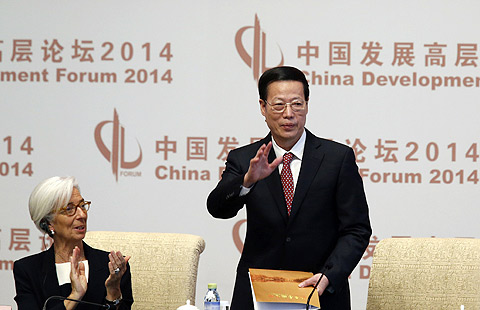New benchmark rate system is necessary
Updated: 2014-03-24 07:34
By Yi Xianrong (China Daily)
|
|||||||||||
The liberalization of deposit rates promised by Zhou Xiaochuan, governor of the People's Bank of China, at a recent news briefing at the annual session of the National People's Congress, will mark the country's final step in allowing banks to set their own interest rates.
"Deposit rate liberalization is on our agenda," Zhou said. "Personally I think it is very likely to be realized
|
 |
 |
China's current ceiling on deposit rates is 110 percent of the benchmark set by its central bank and its controls on deposit rates are expected to be lifted sooner than had been expected. This will mean the basic completion of China's market-based interest rate reforms.
China has never stopped taking steps toward the marketized reform of its interest rate mechanism, which started in 1993, and has achieved significant progress. Except for the upper ceiling put on deposit rates, China has so far imposed very few restrictions on its interest rates.
For example, the prices of China's currency and bond market, including interbank borrowing, national debt, as well as financial and enterprise bonds, are all free of government regulations. Marketized rates for foreign currency deposits and loans have also been adopted in China. Especially since the suspension of the bottom limit for lending rates last July, regulatory measures that have been preserved for the country's credit market are limited to the upper ceiling on deposit rates.
Such gradual marketized rate reforms have strengthened the market's role in the formation of interest rates, but the effects have not been as good as expected and the distortion of the market pricing mechanism and inefficient distribution of resources are still very common.
In other words, China has achieved superficially significant progress in its push for the marketized reform of interest rates, but it has failed to straighten out the distorted interest rates pricing mechanism over the past 20 years.
It has neither formed an effective rates pricing mechanism for its financial market nor remarkably raised the operating efficiency of the domestic financial system.
On the contrary, the rural economy, the private sector and small and medium-sized enterprises that should have benefited more from rate liberalization have not got more room for development than before.
At the same time, some financial innovations created in this process have not been used to raise the financial sector's capability of serving the real economy.
Instead they have been used as a tool for evading financial monitoring or for circulating funds within the financial sector in search of greater profits.
Related Stories
China to open interest rate in one or two years 2014-03-11 11:16
Major banks maintain deposit interest rate 2014-01-26 09:16
China trials new interest rate reform 2013-12-09 18:37
China to launch new vehicle to free interest rates 2013-11-22 22:16
New steps to free up interest rates 2013-09-27 07:07
Today's Top News
China, the Netherlands seek closer co-op
Crimea is part of Russia
Images may help solve jet mystery
Obamas wowed by China
Xi leaves Beijing for first trip to Europe
Beijing beefs up hunt for missing jet
Putin signs law on Crimea accession
Australia to resume ocean search for missing jet
Hot Topics
Lunar probe , China growth forecasts, Emission rules get tougher, China seen through 'colored lens', International board,
Editor's Picks

|

|

|

|

|

|





